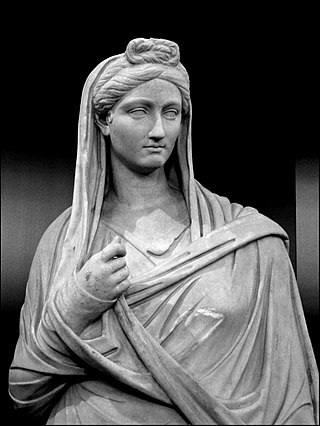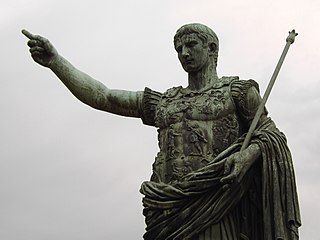
In ancient Roman religion, Ceres was a goddess of agriculture, grain crops, fertility and motherly relationships. She was originally the central deity in Rome's so-called plebeian or Aventine Triad, then was paired with her daughter Proserpina in what Romans described as "the Greek rites of Ceres". Her seven-day April festival of Cerealia included the popular Ludi Ceriales. She was also honoured in the May lustration (lustratio) of the fields at the Ambarvalia festival: at harvest-time: and during Roman marriages and funeral rites. She is usually depicted as a mature woman.
Juventas, also known as Iuventus or Juventus (Greek equivalent: Hebe), was the ancient Roman goddess whose sphere of tutelage was youth and rejuvenation. She was especially the goddess of young men "new to wearing the toga" (dea novorum togatorum)—that is, those who had just come of age.

In ancient Roman religion, Aeternitas was the divine personification of eternity. She was particularly associated with Imperial cult as a virtue of the deified emperor (divus). The religious maintenance of abstract deities such as Aeternitas was characteristic of official Roman cult from the time of the Julio-Claudians to the Severans.
Bonus Eventus was a divine personification in ancient Roman religion. The Late Republican scholar Varro lists him as one of the twelve deities who presided over agriculture, paired with Lympha, the goddess who influenced the water supply. The original function of Bonus Eventus may have been agricultural, but during the Imperial era, he represents a more general concept of success and was among the numerous abstractions who appeared as icons on Roman coins.
A tutelary is a deity or a spirit who is a guardian, patron, or protector of a particular place, geographic feature, person, lineage, nation, culture, or occupation. The etymology of "tutelary" expresses the concept of safety and thus of guardianship.

Religion in ancient Rome consisted of varying imperial and provincial religious practices, which were followed both by the people of Rome as well as those who were brought under its rule.
The pater familias, also written as paterfamilias, was the head of a Roman family. The pater familias was the oldest living male in a household, and could legally exercise autocratic authority over his extended family. The term is Latin for "father of the family" or the "owner of the family estate". The form is archaic in Latin, preserving the old genitive ending in -ās, whereas in classical Latin the normal first declension genitive singular ending was -ae. The pater familias always had to be a Roman citizen.

Freeborn women in ancient Rome were citizens (cives), but could not vote or hold political office. Because of their limited public role, women are named less frequently than men by Roman historians. But while Roman women held no direct political power, those from wealthy or powerful families could and did exert influence through private negotiations. Exceptional women who left an undeniable mark on history include Lucretia and Claudia Quinta, whose stories took on mythic significance; fierce Republican-era women such as Cornelia, mother of the Gracchi, and Fulvia, who commanded an army and issued coins bearing her image; women of the Julio-Claudian dynasty, most prominently Livia and Agrippina the Younger, who contributed to the formation of Imperial mores; and the empress Helena, a driving force in promoting Christianity.

Various lists regarding the political institutions of ancient Rome are presented. Each entry in a list is a link to a separate article. Categories included are: constitutions (5), laws (5), and legislatures (7); state offices (28) and office holders ; political factions and social ranks (8). A political glossary (35) of similar construction follows.

Apotheosis, also called divinization or deification, is the glorification of a subject to divine levels and, commonly, the treatment of a human being, any other living thing, or an abstract idea in the likeness of a deity.

The mos maiorum is the unwritten code from which the ancient Romans derived their social norms. It is the core concept of Roman traditionalism, distinguished from but in dynamic complement to written law. The mos maiorum was collectively the time-honoured principles, behavioural models, and social practices that affected private, political, and military life in ancient Rome.

Juno was an ancient Roman goddess, the protector and special counsellor of the state. She was equated to Hera, queen of the gods in Greek mythology and a goddess of love and marriage. A daughter of Saturn and Ops, she was the sister and wife of Jupiter and the mother of Mars, Vulcan, Bellona, Lucina and Juventas. Like Hera, her sacred animal was the peacock. Her Etruscan counterpart was Uni, and she was said to also watch over the women of Rome. As the patron goddess of Rome and the Roman Empire, Juno was called Regina ("Queen") and was a member of the Capitoline Triad, centered on the Capitoline Hill in Rome, and also including Jupiter, and Minerva, goddess of wisdom.

The Duenos inscription is one of the earliest known Old Latin texts, variously dated from the 7th to the 5th century BC. It is inscribed on the sides of a kernos, in this case a trio of small globular vases adjoined by three clay struts. It was found by Heinrich Dressel in 1880 in the valley between Quirinale and Viminale in Rome. The kernos is part of the collection of the Staatliche Museen in Berlin.

Auctoritas is a Latin word that is the origin of the English word "authority". While historically its use in English was restricted to discussions of the political history of Rome, the beginning of phenomenological philosophy in the 20th century expanded the use of the word.

The jus trium liberorum, meaning "the right of three children" in Latin, was a privilege awarded to Roman citizens who had produced at least three children or freedmen of either sex who had produced at least four children. It was a direct result of the Lex Iulia and the Lex Papia Poppaea, laws introduced by Augustus in 18 BC and 9 AD, respectively. These laws were intended to increase the dwindling population of the Roman upper classes. However, they seem to have also had an important secondary function in the rewarding of amicitia, as the "importance of legacies to Martial and Suetonius can be deduced from their (successful) efforts to obtain the jus trium liberorum"

Manus was an Ancient Roman type of marriage, of which there were two forms: cum manu and sine manu. In a cum manu marriage, the wife was placed under the legal control of the husband. In a sine manu marriage, the wife remained under the legal control of her father.

Augustus was an ancient Roman title given as both name and title to Gaius Julius Caesar Octavianus, Rome's first Emperor. On his death, it became an official title of his successor, and was so used by Roman emperors thereafter. The feminine form Augusta was used for Roman empresses and other female members of the imperial family. The masculine and feminine forms originated in the time of the Roman Republic, in connection with things considered divine or sacred in traditional Roman religion. Their use as titles for major and minor Roman deities of the Empire associated the Imperial system and imperial family with traditional Roman virtues and the divine will, and may be considered a feature of the Roman imperial cult.
In civil law jurisdictions, marital power was a doctrine in terms of which a wife was legally an incapax under the usufructory tutorship of her husband. The marital power included the power of the husband to administer both his wife's separate property and their community property. A wife was not able to leave a will, enter into a contract, or sue or be sued, in her own name or without the permission of her husband. It is very similar to the doctrine of coverture in the English common law, as well as to the Head and Master law property laws.

The Tyche of Constantinople was the deity of fortune (Tyche) who embodied the guardianship (tutela) of the city of Constantinople in the Roman Imperial era. Malalas says that her name was Anthousa. Her attributes included the mural crown, cornucopia, a ship's prow, and a spear. She was depicted standing or seated on a throne. As the personification of the city, Tyche or Anthousa could be abstracted from her origins as a Classical goddess, and like Victory made tolerable as a symbol for Christians. Under Constantine, the Tychai of Rome and Constantinople together might be presented as personifications of the empire ruling the world.















